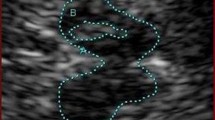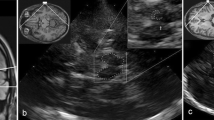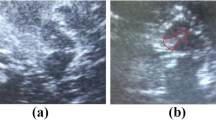Abstract
The aim of this study was to determine the specificity and sensitivity of transcranial sonography (TCS) and the Pocket Smell Test (PST) in differing Parkinson’s disease from essential tremor. The results were compared with the dopamin transporter scan (DaTSCAN) findings. Based on the DaTSCAN finding we formed a group of patients with essential tremor (51 patients) and a group with the Parkinson’s disease (59 patients). The control group consisted of 26 healthy one. To evaluate the olfactory dysfunction the PST was used, whereas by TCS the substantia nigra hyperechogenicity was marked. The sensitivity and specificity of each diagnostic method was statistically calculated. In confirming Parkinson’s disease the specificity of TCS was 88.2 % and the sensitivity 94.9 %. The specificity of PST was 80.4 % whereas the sensitivity was 74.6 %. TCS and PST should be performed to evaluate which patients need to be examined by DaTSCAN.



Similar content being viewed by others
References
Deuschl G, Elble R (2009) Essential tremor–neurodegenerative or nondegenerative disease towards a working definition of ET. Mov Disord 24(14):2033–2041. doi:10.1002/mds.22755
Lacerte A, Chouinard S, Jodoin N, Bernard G, Rouleau GA, Panisset M (2014) Increased prevalence of non-motor symptoms in essential tremor. Tremor Other Hyperkinet Mov (N Y) 4:162. doi:10.7916/D82V2D91
Tan EK, Lee SS, Fook-Chong S, Lum SY (2008) Evidence of increased odds of essential tremor in Parkinson’s disease. Mov Disord 23(7):993–997. doi:10.1002/mds.22005
Shahed J, Jankovic J (2007) Exploring the relationship between essential tremor and Parkinson’s disease. Parkinsonism Relat Disord 13(2):67–76. doi:10.1016/j.parkreldis.2006.05.033
Berardelli A, Wenning GK, Antonini A, Berg D, Bloem BR, Bonifati V, Brooks D, Burn DJ, Colosimo C, Fanciulli A, Ferreira J, Gasser T, Grandas F, Kanovsky P, Kostic V, Kulisevsky J, Oertel W, Poewe W, Reese JP, Relja M, Ruzicka E, Schrag A, Seppi K, Taba P, Vidailhet M (2013) EFNS/MDS-ES/ENS [corrected] recommendations for the diagnosis of Parkinson’s disease. Eur J Neurol 20(1):16–34. doi:10.1111/ene.12022
Bajaj N, Hauser RA, Grachev ID (2013) Clinical utility of dopamine transporter single photon emission CT (DaT-SPECT) with (123I) ioflupane in diagnosis of parkinsonian syndromes. J Neurol Neurosurg Psychiatry 84(11):1288–1295. doi:10.1136/jnnp-2012-304436
Isaias IU, Canesi M, Benti R, Gerundini P, Cilia R, Pezzoli G, Antonini A (2008) Striatal dopamine transporter abnormalities in patients with essential tremor. Nucl Med Commun 29(4):349–353. doi:10.1097/MNM.0b013e3282f4d307
Stenc Bradvica I, Bradvica M, Matic S, Reisz-Majic P (2014) Visual dysfunction in patients with Parkinson’s disease and essential tremor. Neurol Sci. doi:10.1007/s10072-014-1930-2
Gaenslen A, Unmuth B, Godau J, Liepelt I, Di Santo A, Schweitzer KJ, Gasser T, Machulla HJ, Reimold M, Marek K, Berg D (2008) The specificity and sensitivity of transcranial ultrasound in the differential diagnosis of Parkinson’s disease: a prospective blinded study. Lancet Neurol 7(5):417–424. doi:10.1016/S1474-4422(08)70067-X
Walter U (2010) Transcranial sonography in brain disorders with trace metal accumulation. Int Rev Neurobiol 90:166–178. doi:10.1016/S0074-7742(10)90012-3
Budisic M, Trkanjec Z, Lovrencic-Huzjan A, Supanc V, Vukovic V, Demarin V (2009) Transcranial sonography (TCS) in evaluation of patients with essential tremor. Acta Med Croatica 63(Suppl 3):51–54
Vlaar AM, de Nijs T, van Kroonenburgh MJ, Mess WH, Winogrodzka A, Tromp SC, Weber WE (2008) The predictive value of transcranial duplex sonography for the clinical diagnosis in undiagnosed parkinsonian syndromes: comparison with SPECT scans. BMC Neurol 8:42. doi:10.1186/1471-2377-8-42
Sommer U, Hummel T, Cormann K, Mueller A, Frasnelli J, Kropp J, Reichmann H (2004) Detection of presymptomatic Parkinson’s disease: combining smell tests, transcranial sonography, and SPECT. Mov Disord 19(10):1196–1202. doi:10.1002/mds.20141
Duff K, McCaffrey RJ, Solomon GS (2002) The Pocket Smell Test: successfully discriminating probable Alzheimer’s dementia from vascular dementia and major depression. J Neuropsychiatry Clin Neurosci 14(2):197–201
Shah M, Muhammed N, Findley LJ, Hawkes CH (2008) Olfactory tests in the diagnosis of essential tremor. Parkinsonism Relat Disord 14(7):563–568. doi:10.1016/j.parkreldis.2007.12.006
Becker G, Seufert J, Bogdahn U, Reichmann H, Reiners K (1995) Degeneration of substantia nigra in chronic Parkinson’s disease visualized by transcranial color-coded real-time sonography. Neurology 45(1):182–184
Walter U, Niehaus L, Probst T, Benecke R, Meyer BU, Dressler D (2003) Brain parenchyma sonography discriminates Parkinson’s disease and atypical parkinsonian syndromes. Neurology 60(1):74–77
Berg D, Godau J, Walter U (2008) Transcranial sonography in movement disorders. Lancet Neurol 7(11):1044–1055. doi:10.1016/S1474-4422(08)70239-4
Vlaar AM, van Kroonenburgh MJ, Kessels AG, Weber WE (2007) Meta-analysis of the literature on diagnostic accuracy of SPECT in parkinsonian syndromes. BMC Neurol 7:27. doi:10.1186/1471-2377-7-27
Rocca WA, Bower JH, Ahlskog JE, Elbaz A, Grossardt BR, McDonnell SK, Schaid DJ, Maraganore DM (2007) Increased risk of essential tremor in first-degree relatives of patients with Parkinson’s disease. Mov Disord 22(11):1607–1614. doi:10.1002/mds.21584
Chitsaz A, Mehrbod N, Saadatnia M, Fereidan-Esfahani M, Akbari M, Abtahi SH (2013) Transcranial sonography on Parkinson’s disease and essential tremor. J Res Med Sci 18(Suppl 1):S28–S31
Ressner P, Skoloudik D, Hlustik P, Kanovsky P (2007) Hyperechogenicity of the substantia nigra in Parkinson’s disease. J Neuroimaging 17(2):164–167. doi:10.1111/j.1552-6569.2007.00114.x
Stockner H, Sojer M, K KS, Mueller J, Wenning GK, Schmidauer C, Poewe W (2007) Midbrain sonography in patients with essential tremor. Mov Disord 22(3):414–417. doi:10.1002/mds.21344
Doepp F, Plotkin M, Siegel L, Kivi A, Gruber D, Lobsien E, Kupsch A, Schreiber SJ (2008) Brain parenchyma sonography and 123I-FP-CIT SPECT in Parkinson’s disease and essential tremor. Mov Disord 23(3):405–410. doi:10.1002/mds.21861
Hernandez Vara J, Rubiera del Fueyo M, Lorenzo Bosquet C, Castell Conesa J, Molina Cateriano CA, Rodriguez FM (2008) Usefulness of transcranial sonography in Parkinson’s disease. A comparative study using 123I-FP-CIT SPECT. Med Clin (Barc) 131(8):285–289
Huisman E, Uylings HB, Hoogland PV (2004) A 100 % increase of dopaminergic cells in the olfactory bulb may explain hyposmia in Parkinson’s disease. Mov Disord 19(6):687–692. doi:10.1002/mds.10713
McKinnon J, Evidente V, Driver-Dunckley E, Premkumar A, Hentz J, Shill H, Sabbagh M, Caviness J, Connor D, Adler C (2010) Olfaction in the elderly: a cross-sectional analysis comparing Parkinson’s disease with controls and other disorders. Int J Neurosci 120(1):36–39. doi:10.3109/00207450903428954
Haehner A, Hummel T, Hummel C, Sommer U, Junghanns S, Reichmann H (2007) Olfactory loss may be a first sign of idiopathic Parkinson’s disease. Mov Disord 22(6):839–842. doi:10.1002/mds.21413
Braak H, Rub U, Braak E (2000) Neuroanatomy of Parkinson disease. Changes in the neuronal cytoskeleton of a few disease-susceptible types of neurons lead to progressive destruction of circumscribed areas in the limbic and motor systems. Nervenarzt 71(6):459–469
Doty RL (1994) Studies of olfactory dysfunction in major neurological disorders. Adv Biosci 93:593–602
Silveira-Moriyama L, Carvalho Mde J, Katzenschlager R, Petrie A, Ranvaud R, Barbosa ER, Lees AJ (2008) The use of smell identification tests in the diagnosis of Parkinson’s disease in Brazil. Mov Disord 23(16):2328–2334. doi:10.1002/mds.22241
Haehner A, Hummel T, Reichmann H (2009) Olfactory dysfunction as a diagnostic marker for Parkinson’s disease. Expert Rev Neurother 9(12):1773–1779. doi:10.1586/ern.09.115
Busenbark KL, Huber SJ, Greer G, Pahwa R, Koller WC (1992) Olfactory function in essential tremor. Neurology 42(8):1631–1632
Quagliato LB, Viana MA, Quagliato EM, Simis S (2009) Olfaction and essential tremor. Arq Neuropsiquiatr 67(1):21–24 (S0004-282X2009000100006 [pii])
Louis ED, Bromley SM, Jurewicz EC, Watner D (2002) Olfactory dysfunction in essential tremor: a deficit unrelated to disease duration or severity. Neurology 59(10):1631–1633
Vennemann MM, Hummel T, Berger K (2008) The association between smoking and smell and taste impairment in the general population. J Neurol 255(8):1121–1126. doi:10.1007/s00415-008-0807-9
Djaldetti R, Nageris BI, Lorberboym M, Treves TA, Melamed E, Yaniv E (2008) [(123)I]-FP-CIT SPECT and olfaction test in patients with combined postural and rest tremor. J Neural Transm 115(3):469–472. doi:10.1007/s00702-007-0851-0
Chen W, Tan YY, Hu YY, Zhan WW, Wu L, Lou Y, Wang X, Zhou Y, Huang P, Gao Y, Xiao Q, Chen SD (2012) Combination of olfactory test and substantia nigra transcranial sonopraphy in the differential diagnosis of Parkinson’s disease: a pilot study from China. Transl Neurodegener 1(1):25. doi:10.1186/2047-9158-1-25
Busse K, Heilmann R, Kleinschmidt S, Abu-Mugheisib M, Hoppner J, Wunderlich C, Gemende I, Kaulitz L, Wolters A, Benecke R, Walter U (2012) Value of combined midbrain sonography, olfactory and motor function assessment in the differential diagnosis of early Parkinson’s disease. J Neurol Neurosurg Psychiatry 83(4):441–447. doi:10.1136/jnnp-2011-301719
Poewe W, Mahlknecht P (2012) Combined assessment of midbrain hyperechogenicity, hyposmia and motor asymmetry improves diagnostic accuracy in early Parkinson’s disease. Expert Rev Neurother 12(8):911–914. doi:10.1586/ern.12.75
Conflict of interest
The authors declare that they have no conflict of interest.
Ethical standard statement
This study has been approved by Ethical committee of University Hospital Center in Osijek and has, therefore, been performed in accordance with the ethical standards laid down in the 1964 Declaration of Helsinki and its later amendments.
Informed consent statement
All patients gave their informed consent prior to their inclusion in the study.
Author information
Authors and Affiliations
Corresponding author
Rights and permissions
About this article
Cite this article
Štenc Bradvica, I., Mihaljević, I., Butković-Soldo, S. et al. Transcranial sonography and the pocket smell test in the differential diagnosis between parkinson’s disease and essential tremor. Neurol Sci 36, 1403–1410 (2015). https://doi.org/10.1007/s10072-015-2152-y
Received:
Accepted:
Published:
Issue Date:
DOI: https://doi.org/10.1007/s10072-015-2152-y




